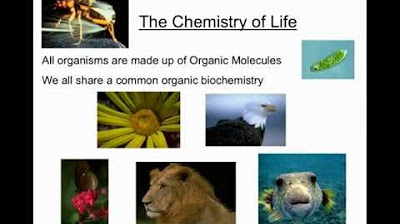4. Biological Molecules (Cambridge IGCSE Biology 0610 for exams in 2023, 2024 and 2025)
Summary
TLDRThis IGCSE study video covers biological molecules, focusing on carbohydrates, fats, and proteins—organic molecules essential for life. It explains the structure of monosaccharides, disaccharides, and polysaccharides in carbohydrates, and the composition of fats from fatty acids and glycerol. Proteins are described as chains of amino acids, with variations leading to diverse protein structures. The video also details food tests for identifying starch, reducing sugars, proteins, fats, oils, and vitamin C, and concludes with an overview of DNA's double helix structure and base pairing.
Takeaways
- 🌿 The bodies of living organisms are composed of various chemicals, including carbohydrates, fats, and proteins, which are organic molecules containing carbon, hydrogen, and oxygen.
- 🍬 Carbohydrates are large molecules made up of simple sugar molecules like monosaccharides (e.g., glucose), disaccharides (e.g., maltose), and polysaccharides (e.g., starch, glycogen, or cellulose).
- 🍯 Fats, or lipids, are made from fatty acids and glycerol, with oils being liquid fats at room temperature, and each fat molecule consisting of one glycerol molecule bonded to three fatty acid chains.
- 🥚 Proteins are composed of long chains of amino acids, with about 20 different types that can be arranged in various orders to create a vast array of proteins.
- 🧪 Food tests can identify the presence of starch, reducing sugars, proteins, fats, oils, and vitamin C in food samples through specific reactions and color changes.
- 🟣 The starch test involves adding iodine solution, which turns blue-black in the presence of starch, indicating its presence.
- 🟠 The reducing sugar test uses Benedict's solution, which changes from blue to orange or brick red when heated with a food sample containing reducing sugars.
- 🟣 The protein test involves the addition of biuret reagent, which turns from blue to violet or purple, confirming the presence of protein in the food sample.
- 🥛 The fat and oil test mixes the food sample with ethanol, and when added to cold water, a cloudy or milky emulsion indicates the presence of fats or oils.
- 🟢 The vitamin C test uses dcpip solution, which turns colorless when mixed with a food sample containing vitamin C, indicating its presence.
- 🧬 DNA, or deoxyribonucleic acid, is the molecule containing the genetic instructions for all organisms, structured as a double helix with two strands held together by base pairs (A-T and C-G).
Q & A
What are the three main categories of molecules found in living organisms?
-The three main categories of molecules found in living organisms are carbohydrates, fats, and proteins.
Why are carbohydrates, fats, and proteins referred to as organic molecules?
-Carbohydrates, fats, and proteins are referred to as organic molecules because they all contain carbon, hydrogen, and oxygen, with proteins also containing nitrogen and sometimes sulfur.
What is the simplest form of sugar molecules known as?
-The simplest form of sugar molecules is known as monosaccharides, with glucose being an example.
How are maltose and starch related to glucose molecules?
-Maltose is formed when two glucose molecules join together, and starch is a polysaccharide formed when many glucose molecules join together.
What are the basic units of fats or lipids?
-The basic unit of fats is one glycerol molecule chemically bonded to three fatty acid chains.
What is the difference between oils and fats?
-Oils are fats that are liquid at room temperature.
How many different amino acids are there, and what do they form when combined?
-There are about 20 different amino acids, and when combined, they form long chains that make up protein molecules.
What happens when iodine solution is added to a food sample containing starch?
-When iodine solution is added to a food sample containing starch, the color changes from orange-brown to blue-black.
How is the presence of reducing sugars in a food sample tested?
-The presence of reducing sugars in a food sample is tested by adding Benedict's solution, heating it in a water bath, and observing a color change from blue to orange or brick red.
What color change indicates a positive test for protein in a food sample?
-A positive test for protein in a food sample is indicated by a color change from blue to violet or purple when biuret solution is added.
How can the presence of fats or oils in a food sample be determined?
-The presence of fats or oils in a food sample can be determined by mixing the sample with ethanol, adding it to cold water, and observing the formation of a cloudy or milky emulsion.
What is the structure of a DNA molecule, and how are the two strands held together?
-A DNA molecule consists of two strands wound around each other in a double helix. The strands are held together by hydrogen bonds between pairs of bases, which always pair up in the same way: adenine (A) with thymine (T), and cytosine (C) with guanine (G).
Outlines

Dieser Bereich ist nur für Premium-Benutzer verfügbar. Bitte führen Sie ein Upgrade durch, um auf diesen Abschnitt zuzugreifen.
Upgrade durchführenMindmap

Dieser Bereich ist nur für Premium-Benutzer verfügbar. Bitte führen Sie ein Upgrade durch, um auf diesen Abschnitt zuzugreifen.
Upgrade durchführenKeywords

Dieser Bereich ist nur für Premium-Benutzer verfügbar. Bitte führen Sie ein Upgrade durch, um auf diesen Abschnitt zuzugreifen.
Upgrade durchführenHighlights

Dieser Bereich ist nur für Premium-Benutzer verfügbar. Bitte führen Sie ein Upgrade durch, um auf diesen Abschnitt zuzugreifen.
Upgrade durchführenTranscripts

Dieser Bereich ist nur für Premium-Benutzer verfügbar. Bitte führen Sie ein Upgrade durch, um auf diesen Abschnitt zuzugreifen.
Upgrade durchführenWeitere ähnliche Videos ansehen

Biological Molecules | IGCSE Biology | Topic Explainer - ZNotes

AP Biology Unit 1: Chemistry of Life Summary

Biological Molecules | Cells | Biology | FuseSchool

Organic Biochemistry Screencast Session 1.mp4

Komponen kimiawi sel - biologi sma bab sel kelas - komponen sel

What is Biochemistry? What do Biochemists study? 🦋 Biology
5.0 / 5 (0 votes)
